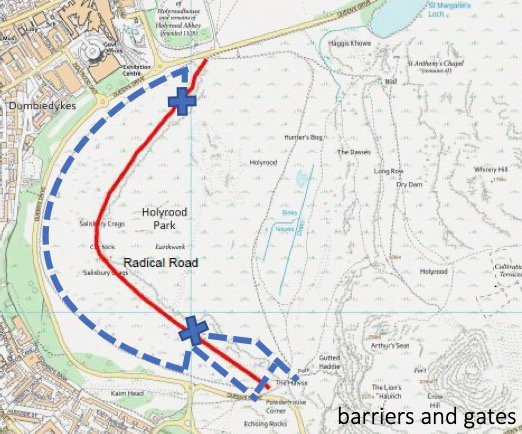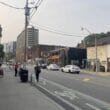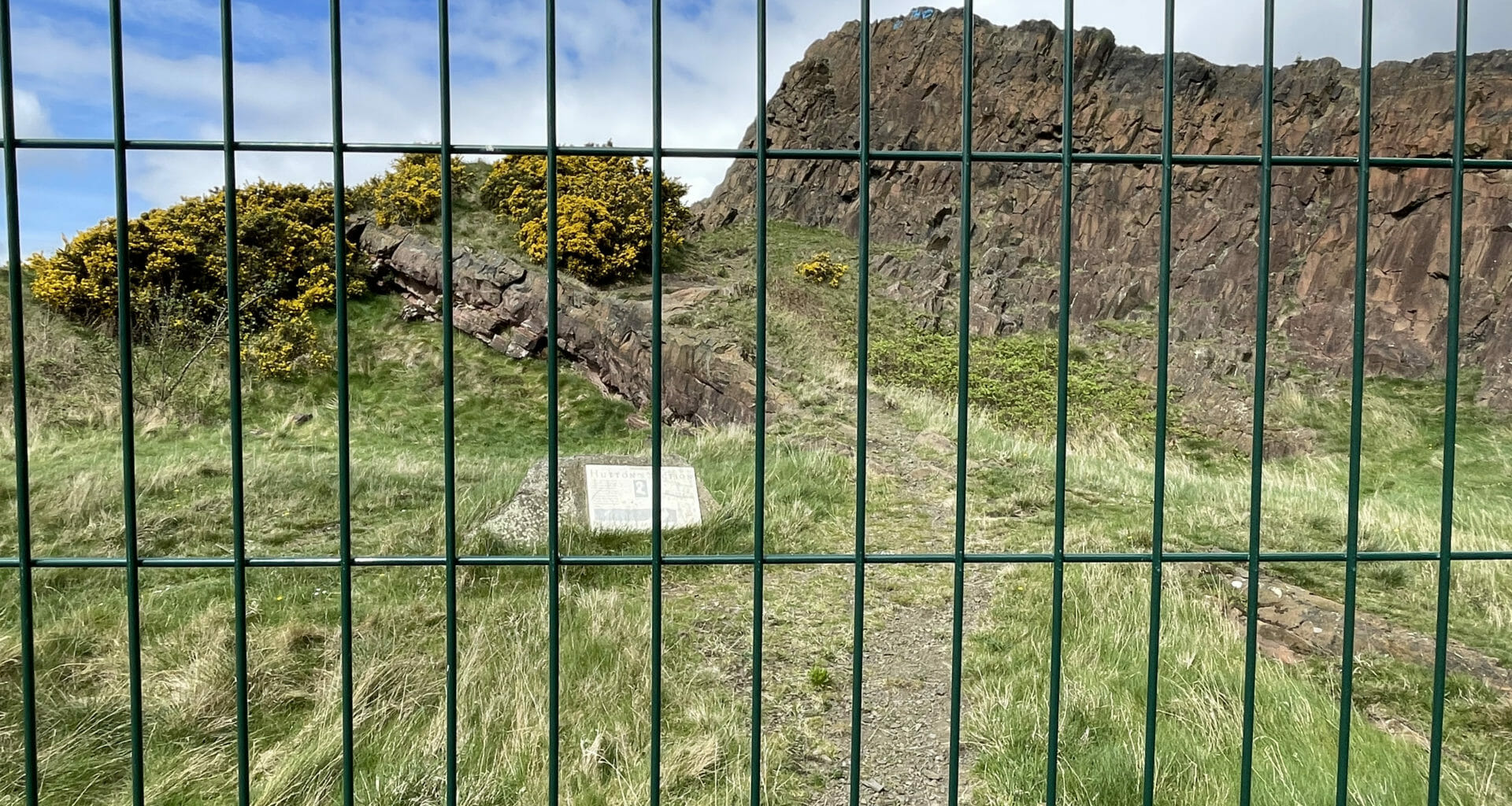The public could be banned forever from one of Edinburgh’s most historic and popular footpaths, under plans being considered by a Scottish Government agency.
An internal report by Historic Environment Scotland (HES), obtained by The Ferret, reveals that the leading option for Radical Road around Arthur’s Seat is to “permanently prohibit all access”. The route has been fenced off for more than three and a half years because of the risk of rock falls.
The prospect has alarmed walkers, climbers and geologists, who warned that permanent closure would create “a terrible precedent”, putting public health and tourism at risk. They accused HES of failing to consult or to listen, and of assuming it “knows best”.
HES said it was still consulting experts and partners on “the most appropriate option” for Radical Road. It did not rule out permanent closure, insisting that “the health and safety of our visitors and staff must always be paramount”.
Radical Road runs for three-quarters of a mile beneath Salisbury Crags, near the Scottish Parliament, towards the top of Arthur’s Seat. Giving panoramic views over Edinburgh, it used to be one of the main attractions in Holyrood Park, which is visited by more than two million people every year.
The road was famously built by unemployed weavers from the west of Scotland two years after the Radical War of 1820. The project was suggested by Sir Walter Scott to try and avoid further political unrest.
In recent decades the path has attracted hundreds of walkers and joggers a day, while the crags above have long challenged climbers. A section at the south end is internationally renowned to geologists as a place which inspired the 18th century “father of modern geology”, James Hutton.
But HES closed Radical Road after it was hit by 50 tonnes of rock falling from Salisbury Crags on the afternoon of 11 September 2018. No-one was injured, but the incident was regarded by HES as a “near miss”.
HES initially erected temporary barriers to prevent access. In the summer of 2021 these were replaced by two-metre high, weighted, wire fences with locked gates and warning notices at every access point.
Now a 24-page “options appraisal” conducted by HES in 2021 has been released to The Ferret under freedom of information law. It concluded that making the existing restrictions permanent was the safest — and cheapest — option.
“A permanent closure of the Radical Road footpath would achieve the highest reduction in residual risk of injury to visitors and staff, and would allow Salisbury Crags to remain fundamentally unchanged, preserving the fabric and iconic setting within gates and high barriers,” the HES report said.
“Loss of this established footpath and the installation of permanent prohibition measures across all routes above and below the crags is likely to attract some negative public response.”
The capital costs of keeping the path shut were estimated at between £50,000 and £150,000, plus maintenance costs. A map showed a proposed fence stretching for a mile around the bottom of Radical Road, and enclosing both ends.

Other options included wrapping Salisbury Crags completely or partially in wire mesh, building a tunnel, or engineering a new road sticking out from the cliff. The HES report estimated that these would each cost a minimum of £2.5 million, and would have a “high impact” on a “unique and iconic landscape”.
The option of re-opening the footpath with increased monitoring was rated as a “high to very high” risk to visitors. It was reckoned to cost between £50,000 and £100,000 for each inspection, plus expert fees.
According to the HES report, the risks have “clearly increased” in recent years, partly because of climate change. Rocks break off after being fractured by heavy rain, repeated freezing and thawing, and the roots of invasive plants.
Existing barriers have also failed to keep people out, the report said, with some “bypassing and moving the signage and barriers” and “ignoring clearly signed closures”. HES had received “regular complaints” from the public and politicians.
Ramblers Scotland demanded to know more about the “true risks” to walkers. “It is sad and worrying to hear of the permanent threat to this iconic and historic path,” said the outdoor group’s director, Brendan Paddy.
“We would urge decision-makers to carefully weigh any rockfall risk against the major negative impact of closure upon tourism and residents’ health and happiness.”
Another outdoor group, Mountaineering Scotland, wrote to HES in November 2021 complaining about the prolonged closure of Radical Road. It was concerned that there had been no consultation with the Edinburgh access forum.
“While we understand the responsibilities HES has regarding health and safety, it appears to be taking the same approach to managing access to a public park as it does to their historic buildings,” the group’s chief executive, Stuart Younie, told The Ferret.
“It’s particularly disappointing that there appears to be no commitment to ensuring access is reinstated or any indication of when mitigating action will be taken to enable this to happen.”

The mountain campaigner and blogger, Nick Kempe, pointed out that Holyrood Park was not covered by the public access rights introduced in the 2003 Land Reform Act. “Nowhere else in Scotland would it be possible for a public authority or private landowner to consider the permanent closure of an area of land to the public,” he said.
“It is time for MSPs to intervene and amend the Holyrood Park regulations to bring them into line with the Land Reform Act. That is the only way to ensure that the access problem which has been visible from the Scottish Parliament building for the last three and a half years is now addressed.”
Angus Miller, vice-chair of the Scottish Geology Trust, has run geology tours in Holyrood Park for over 20 years. “HES seems to be giving no consideration to the overall risk management in the park,” he said.
“They are fixated on minimising the risk from falling rocks, without seeming to consider the knock-on effect that the Radical Road closure has in pushing many more visitors along the top of Salisbury Crags.”
Miller predicted that permanent closure would be strongly opposed. “HES is creating a terrible precedent by wholesale restriction of access that seems at odds with the principles of outdoor access in Scotland,” he argued.
“But HES knows best, and they appear not to be listening, or willing to explain, or to discuss their plans.”
The climbing guidebook author, Topher Dagg, warned that barring access would send “a dangerous and draconian message” that beautiful mountains and coastlines were places to be feared, rather than enjoyed.
“The crags have for many years been a place of peace and solace within the city and stresses of life,” he said. “I can honestly credit evenings climbing at the crags, as the sun sinks down into distant mountains, as having a measurable, positive impact on my mental health during hard times.”

Historic Environment Scotland has not yet made a final decision on what to do. “We previously identified a risk of rockfall which could potentially cause death or serious injury on a section of the Radical Road and as a result were forced to restrict public access in this area,” an HES spokesperson told The Ferret.
“We continue to consult external specialist and partners on what is the most appropriate option to best remedy this situation, including discussions with relevant regulatory bodies to consider next moves in more detail.
“In the meantime, unfortunately access will remain closed. While it is never ideal or desirable to limit public access, and we acknowledge this area of the park has remained closed for some time now, the health and safety of our visitors and staff must always be paramount.”
The report released by Historic Environment Scotland
Photos and video by Rob Edwards.














